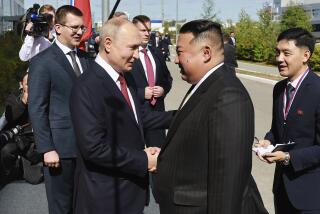6 Nations Act to Create Asian Growth Center : Economy: The former adversaries hope to spur development of the Tumen River region, where China, Russia, North Korea meet.
- Share via
SEOUL — Six historically hostile nations took a step Friday on a long journey toward creating a new growth center in Northeast Asia.
North and South Korea, China, Mongolia, Russia and Japan set up a management committee to work out plans and methods to finance the development of the Tumen River region, where the borders of North Korea, China and Russia come together.
Krishan G. Singh, regional director for Asia and the Pacific of the U.N. Development Program, told reporters after a two-day meeting here that the six nations will coordinate their blueprints with each other to ensure “harmonization.” Development could cost as much as $30 billion over 20 years, he said.
They also agreed to open the project to participation from other countries, including the United States, and to international organizations. Already, the Asian Development Bank, which sent an observer here, has offered to finance technical assistance. Eventually, the World Bank would be asked to participate, Singh said.
The key to the future, he said, will come at the end of 1993, when the blueprints will be submitted to each of the six governments for approval at the highest level.
The Tumen project--although still in the concept stage--made a bit of history just by bringing the six nations together here.
For the first time, representatives of the Communist North Korean government crossed the demilitarized zone separating north and south to attend a multinational conference here.
And as recently as 1988, when Seoul staged the Olympics, neither Russia nor Mongolia had diplomatic ties with South Korea. Formal relations still do not exist between China and South Korea, nor between Japan and North Korea.
Until a dispute is settled between North and South Korea over inspections of nuclear facilities in the north, South Korea will move “not one inch” toward economic cooperation with the north, Seoul warned Pyongyang last week.
But the Tumen project looks further into the future. “Tumen would take off toward the end of the century and enter full development early next century,” Singh said, adding that his agency will spend about $3 million to help the six nations coordinate their planning in the next year and a half.
The idea is to link capital and technology from at least Japan and South Korea with the cheap and plentiful labor and natural resources near the mouth of the Tumen to build a year-round ocean port city of 500,000 people. Project supporters then envision providing a “land bridge” via railway across the Asian continent to Europe.
The proposal offers something for all involved:
For North Korea, it could stimulate development on its backward eastern coast.
For South Korea, links to Tumen could spark growth on its undeveloped northeast coast. Instead of investing in Southeast Asia in search of cheap labor, South Korean firms also would find the Tumen region “an attractive base upon which to prop up the competitiveness of their manufacturing,” said Yoon Young Dae, international policy coordinator of South Korea’s Economic Planning Board.
For China, the project would provide a counterbalance to rapid development farther south around Canton, Shanghai and Dalian.
For landlocked Mongolia, an opening to the sea would emerge.
For Russia, the proposal offers a spur to help its eastern regions catch up with its western section.
And for Japan, the project could be a boon to economically lagging, long-neglected areas facing the Asian continent.
But established interests in developed regions in each country may resist efforts to switch resources to the Tumen project.
North Korea already has designated its northeast cities of Najin and Sungbong as “special economic zones for development.”
The U.N. agency said all six nations had agreed that the Tumen development should stretch from Vladivostok, Russia, to Chongjin, North Korea, and Hunchun, China.
More to Read
Sign up for Essential California
The most important California stories and recommendations in your inbox every morning.
You may occasionally receive promotional content from the Los Angeles Times.










